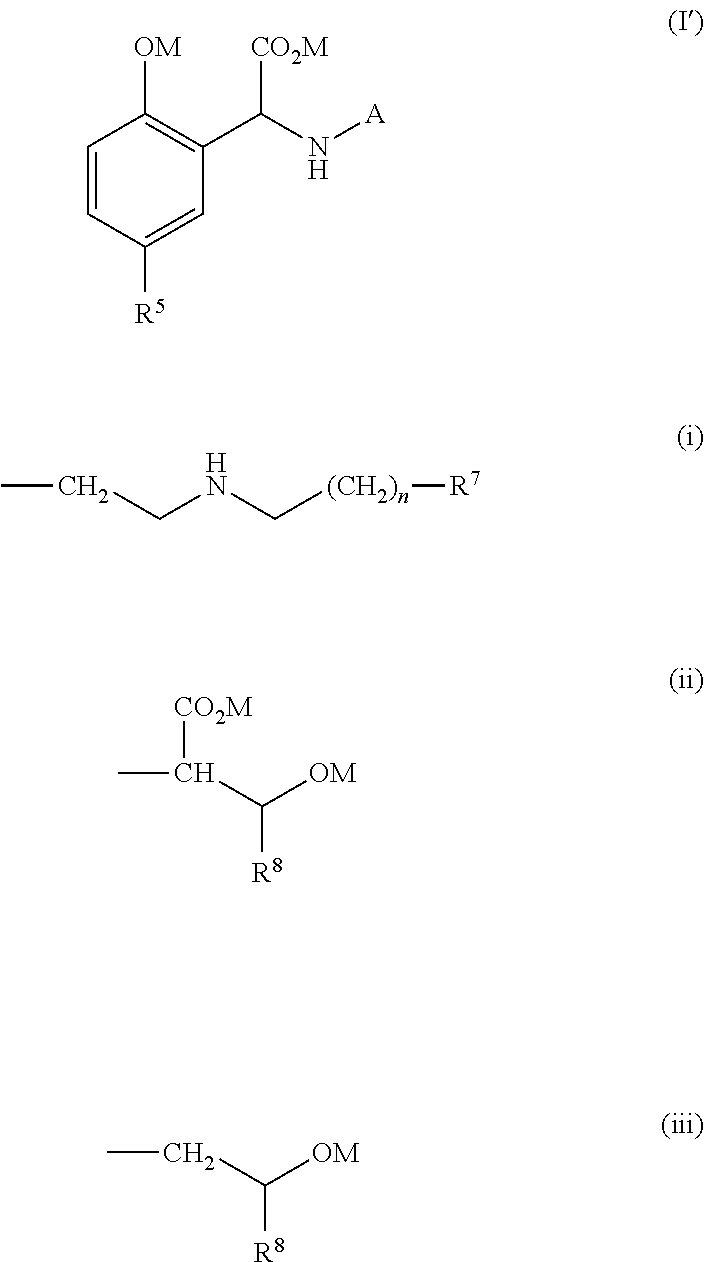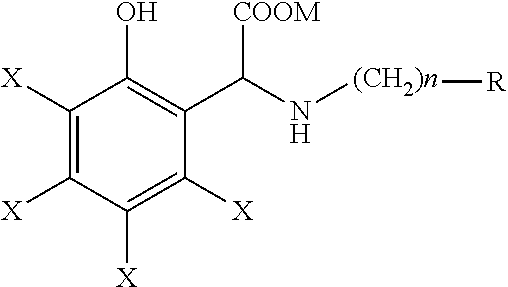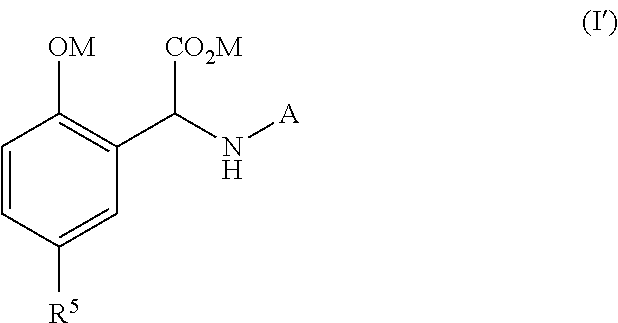Process for the preparation of a chelating agent
a technology of chelating agent and process, which is applied in the field of process for the preparation of chelating agent, can solve the problems of poor results achieved in these processes, and achieve the effect of improving the yield
- Summary
- Abstract
- Description
- Claims
- Application Information
AI Technical Summary
Benefits of technology
Problems solved by technology
Method used
Image
Examples
example 1
on of monoethanolamine-N-(2-hydroxyphenylacetic acid (MEAHA)
[0124]
[0125]To 940 g (10 mol) of phenol at 40° C., 61 g (1 mol) of monoethanolamine was slowly added without leaving the temperature to raise over 45° C. Once the addition was finished, the reaction mixture was allowed to cool down and 80 g (1 mol) of 50% w / w sodium hydroxide aqueous solution was added. After cooling the reaction crude to 35° C., 148 g (1 mol) of 50% w / w glyoxylic acid aqueous solution was slowly and continuously added, keeping the temperature under 40° C. during all the reaction. Then, the mixture was allowed to react for 2-4 hours at 70-75 C. Finally, 90 g (5 mol) of water were added and the aqueous phase was extracted twice with 1120 g (10 mol) of chlorobenzene. The aqueous phase contained the chelating agent MEAHA. Chelation of Fe-MEAHA was subsequently made directly over the obtained aqueous solution.
[0126]For the chelation, to the aqueous solution obtained above containing the chelating agent MEAHA, 1...
example 2
on of monoethanolamine-N-(2-hydroxy-5-methyl-phenylacetic acid (CREMEAHA)
[0128]
[0129]To 1080 g (10 mol) of p-cresol at 40° C., 61 g (1 mol) of monoethanolamine was slowly added without leaving the temperature to raise over 45° C. Once the addition was finished, the reaction mixture was allowed to cool down and 80 g (1 mol) of 50% w / w sodium hydroxide aqueous solution was added. After cooling the reaction crude to 35° C., 148 g (1 mol) of 50% w / w glyoxylic acid aqueous solution was slowly and continuously added, keeping the temperature under 40° C. during all the reaction. Then, the mixture was allowed to react for 2-4 hours at 70-75° C. Finally, 90 g (5 mol) parts of water were added and the aqueous phase was extracted twice with 1120 g (10 mol) of chlorobenzene. The aqueous phase contained the chelating agent CREMEAHA. Chelation of Fe-CREMEAHA was subsequently made directly over the obtained aqueous solution.
[0130]For the chelation, to the aqueous solution obtained above containing...
example 3
on of aminoethylethanolamine-N-(2-hydroxyphenylacetic acid (NEAHA)
[0132]
[0133]To 940 g (10 mol) of phenol at 40° C., 106 g (1 mol) of aminoethylethanolamine was slowly added without leaving the temperature to raise over 45° C. Once the addition was finished, the reaction mixture was allowed to cool down and 80 g (1 mol) of 50% w / w sodium hydroxide aqueous solution was added. After cooling the reaction crude to 35° C., 148 g (1 mol) of 50% w / w glyoxylic acid aqueous solution was slowly and continuously added, keeping the temperature under 40° C. during all the reaction. Then, the mixture was allowed to react for 2-4 hours at 70-75° C. Finally, 90 g (5 mol) parts of water were added and the aqueous phase was extracted twice with 1120 g (10 mol) of chlorobenzene. The aqueous phase contained the chelating agent NEAHA. Chelation of Fe-NEAHA was subsequently made directly over the obtained aqueous solution.
[0134]For the chelation, to the aqueous solution obtained above containing the chel...
PUM
| Property | Measurement | Unit |
|---|---|---|
| temperature | aaaaa | aaaaa |
| temperature | aaaaa | aaaaa |
| temperature | aaaaa | aaaaa |
Abstract
Description
Claims
Application Information
 Login to View More
Login to View More - R&D
- Intellectual Property
- Life Sciences
- Materials
- Tech Scout
- Unparalleled Data Quality
- Higher Quality Content
- 60% Fewer Hallucinations
Browse by: Latest US Patents, China's latest patents, Technical Efficacy Thesaurus, Application Domain, Technology Topic, Popular Technical Reports.
© 2025 PatSnap. All rights reserved.Legal|Privacy policy|Modern Slavery Act Transparency Statement|Sitemap|About US| Contact US: help@patsnap.com



